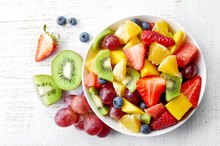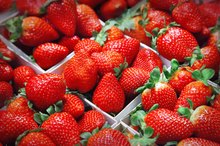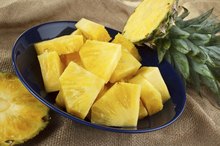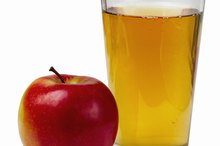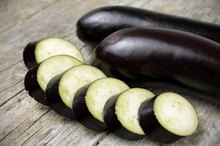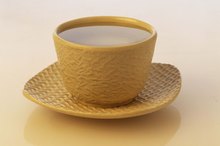What does fact checked mean?
At Healthfully, we strive to deliver objective content that is accurate and up-to-date. Our team periodically reviews articles in order to ensure content quality. The sources cited below consist of evidence from peer-reviewed journals, prominent medical organizations, academic associations, and government data.
- Cancer Chemotherapy and Pharmacology: Oral Therapy with Proteolytic Enzymes Decreases Excessive TGF-beta Levels in Human Blood
- Cancer Chemotherapy and Pharmacology: Oral Therapy with Proteolytic Enzymes Decreases Excessive TGF-beta Levels in Human Blood
- Arthritis and Rheumatism: The Effects of Vitamin C Supplementation on Serum Concentrations of Uric Acid -Results of a Randomized Controlled Trial
- Arthritis and Rheumatism: The Effects of Vitamin C Supplementation on Serum Concentrations of Uric Acid -Results of a Randomized Controlled Trial
The information contained on this site is for informational purposes only, and should not be used as a substitute for the advice of a professional health care provider. Please check with the appropriate physician regarding health questions and concerns. Although we strive to deliver accurate and up-to-date information, no guarantee to that effect is made.
Pineapple for Gout
Pineapple is low in calories, cholesterol-free and rich in essential nutrients like manganese, copper and vitamin C. It also contains compounds that may make it a good fruit to include regularly in your diet if you have gout, though more research is needed. Gout is typically managed through a combination of medication and dietary changes. Do not attempt to self-treat gout only with foods like pineapple until you've spoken to your doctor.
Purine Concentration
Individuals with gout follow a low-purine diet 3. Purines are compounds found in foods like game meats, organ meats, meat extracts and broths and seafood such as mussels, mackerel and scallops. Purines are metabolized by the body into uric acid, the compound that builds up in the joints of people with gout. A low-purine diet focuses primarily on foods with 50 milligrams or fewer purines per 100 grams of the food 3. Pineapple -- along with all other fruits -- belongs in this low-purine category 3.
Effect of Bromelain
Citric Acid and Gout
Learn More
Pineapple is the only natural source of bromelain, the name given to a group of enzymes that break down protein. A study published in 2001 in "Cancer Chemotherapy and Pharmacology" reported that bromelain, along with similar enzymes, lowers the amount of transforming growth factor-beta in people who have rheumatoid arthritis 5. A decrease in excessive transforming growth factor-beta may help alleviate arthritis symptoms, theorized the researchers. Since gout is a type of inflammatory arthritis, gout sufferers may also benefit from supplemental bromelain, though more research is needed 6. It is not yet known if eating pineapple can give you enough bromelain to help manage gout.
Effect of Vitamin C
A single cup of pineapple chunks contains 79 milligrams of vitamin C. This amount supplies nearly 88 percent of a man's recommended daily allowance and over 100 percent of a woman's requirement. A study published in 2005 by "Arthritis and Rheumatism" determined that a high intake of vitamin C lowers your blood's uric acid level and may help treat and prevent gout 6. The subjects in the study took 500 milligrams of vitamin C each day for two months. Although pineapple and other fruits and vegetables are excellent sources of vitamin C, it may not be possible for people to consume enough vitamin C regularly through diet to replicate the study results.
- A single cup of pineapple chunks contains 79 milligrams of vitamin C. This amount supplies nearly 88 percent of a man's recommended daily allowance and over 100 percent of a woman's requirement.
- A study published in 2005 by "Arthritis and Rheumatism" determined that a high intake of vitamin C lowers your blood's uric acid level and may help treat and prevent gout 6.
Recommended Intake
Strawberries for Gout
Learn More
Unlike fruits such as:
- apples
- watermelon
- pears
- grapes
- mangoes
- plums
- pineapple is low in fructose
A British Medical Journal study from 2008 found that a diet high in fructose was linked to an increased risk of gout. Because it is a low-fructose food, pineapple can be used freely to fulfill the two to four daily servings of fruit recommended by the University of Pittsburgh Medical Center for people with gout 7. A cup of pineapple slices or chunks is equivalent to one serving.
Related Articles
References
- USDA National Nutrient Database: Full Report (All Nutrients) - 09266, Pineapple, Raw, All Varieties
- Dr. Gourmet: What is the Arthritis Known as Gout?
- UPMC: Low-Purine Diet
- NYU Langone Medical Center: Bromelain
- Cancer Chemotherapy and Pharmacology: Oral Therapy with Proteolytic Enzymes Decreases Excessive TGF-beta Levels in Human Blood
- Arthritis Foundation: Gout
- University of Maryland Medical Center: Vitamin C (Ascorbic Acid)
- Arthritis and Rheumatism: The Effects of Vitamin C Supplementation on Serum Concentrations of Uric Acid -Results of a Randomized Controlled Trial
- UVA Digestive Health Center: Low Fructose Diet
- National Institute of Arthritis and Musculoskeletal and Skin Diseases. Gout. Updated April 2016.
- Zhang Y, Chen C, Choi H, et al. Purine-rich foods intake and recurrent gout attacks. Ann Rheum Dis. 2012; 71(9):1448-53. doi:10.1136/annrheumdis-2011-201215
- Fischer E. Ueber die Harnsauer. 1 [On Uric Acid. 1]. Berichte der Deutschen Chemischen Gesellschaft. 1884: 17:328-338. doi:10.1002/cber.18980310304
- Ragab, G., Elshahaly, M., & Bardin, T. (2017). Gout: An old disease in new perspective – A review. Journal of Advanced Research, 8(5), 495–511. doi:10.1016/j.jare.2017.04.008
- Centers for Disease Control and Prevention. Gout. Updated January 28, 2019.
- Zgaga, L., Theodoratou, E., Kyle, J., Farrington, S. M., Agakov, F., Tenesa, A., … Campbell, H. (2012). The Association of Dietary Intake of Purine-Rich Vegetables, Sugar-Sweetened Beverages and Dairy with Plasma Urate, in a Cross-Sectional Study. PLoS ONE, 7(6), e38123. doi:10.1371/journal.pone.0038123
- Choi HK, Gao X, Curhan G. Vitamin C intake and the risk of gout in men: a prospective study. Arch Intern Med. 2009;169(5):502–507. doi:10.1001/archinternmed.2008.606
- Zhang Y, Neogi T, Chen C, Chaisson C, Hunter DJ, Choi HK. Cherry consumption and decreased risk of recurrent gout attacks. Arthritis Rheum. 2012;64(12):4004–4011. doi:10.1002/art.34677
- Arthritis Foundation. Gout Diet: Dos and Don’ts.
- Boban M, Modun D. Uric acid and antioxidant effects of wine. Croat Med J. 2010;51(1):16–22. doi:10.3325/cmj.2010.51.16
- Caliceti C, Calabria D, Roda A, Cicero AFG. Fructose Intake, Serum Uric Acid, and Cardiometabolic Disorders: A Critical Review. Nutrients. 2017;9(4):395. Published 2017 Apr 18. doi:10.3390/nu9040395
- U.S. Department of Health and Human Services and U.S. Department of Agriculture. 2015–2020 Dietary Guidelines for Americans. 8th Edition. Published December 2015.
- U.S. Department of Health and Human Services. Gripped by Gout. NIH News in Health. Published February 2014.
- Kakutani-Hatayama M, Kadoya M, Okazaki H, et al. Nonpharmacological Management of Gout and Hyperuricemia: Hints for Better Lifestyle. Am J Lifestyle Med. 2015;11(4):321–329. Published 2015 Sep 2. doi:10.1177/1559827615601973
Resources
Writer Bio
Michelle Kerns writes for a variety of print and online publications and specializes in literature and science topics. She has served as a book columnist since 2008 and is a member of the National Book Critics Circle. Kerns studied English literature and neurology at UC Davis.
